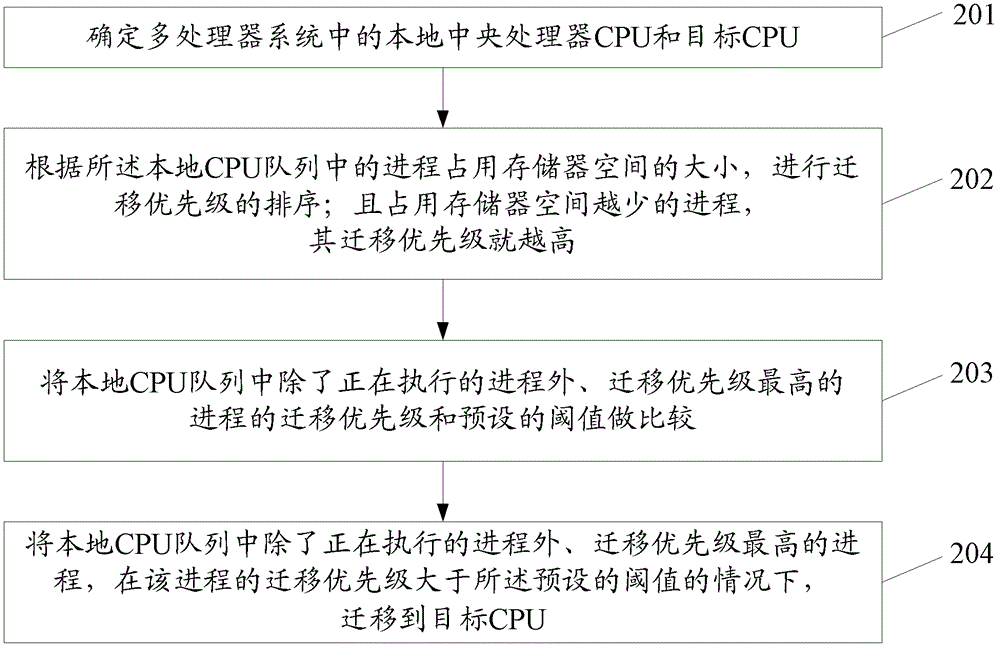Method and device for multiprocessor system load balancing
A multi-processor system, load balancing technology, applied in multi-programming devices, electrical digital data processing, instruments, etc., can solve problems affecting system performance, etc.
- Summary
- Abstract
- Description
- Claims
- Application Information
AI Technical Summary
Problems solved by technology
Method used
Image
Examples
Embodiment 1
[0026] Such as figure 1 As shown, the embodiment of the present invention provides a method for multiprocessor system load balancing, including:
[0027] Step 101, determine the local central processing unit CPU and the target CPU in the multiprocessor system;
[0028] For a multiprocessor system, whether there is load imbalance in the multiprocessor system is detected every time the clock is interrupted, and load balancing processing needs to be performed in the case of load imbalance in the multiprocessor system. The load balancing process refers to migrating a process from a CPU with a large load to a CPU with a small load; wherein, the CPU from which the process migrates is called the local CPU, and the CPU from which the process migrates is called the target CPU; generally speaking, A CPU with a heavy load can be used as a local CPU, and a CPU with a light load can be used as a target CPU.
[0029] Step 102: Perform migration priority sorting according to the size of th...
Embodiment 2
[0038] Considering that in certain application environments or scenarios, the multiprocessor system needs to meet the load requirements of the certain application environments or scenarios. In the load balancing method for a multiprocessor system provided by the embodiment of the present invention, a threshold is set in advance for the migration priority according to the load requirements of the multiprocessor system in an application environment or scenario.
[0039] Such as figure 2 As shown, the method for multiprocessor system load balancing provided by the embodiment of the present invention includes:
[0040] Step 201, determine the local CPU and target CPU in the multiprocessor system;
[0041] Refer to step 101.
[0042] Step 202: Perform migration priority sorting according to the size of the memory space occupied by the processes in the local CPU queue; and the process that occupies less memory space has a higher migration priority;
[0043] The explanation of th...
Embodiment 3
[0051] Since the execution time of a process can reflect the size of the memory space occupied by the process to a certain extent, generally speaking, the execution time of the process and the memory space occupied by the process form a positive functional relationship, that is, the longer the execution time of the process, the Indicates that the process takes up more memory space. The execution time of the process refers to the time spent from the start of execution to the end of execution of the process. Based on the above considerations, as image 3 As shown, the embodiment of the present invention provides another method for load balancing of a multiprocessor system.
[0052] Step 301, determine the local central processing unit CPU and the target CPU in the multiprocessor system;
[0053] Refer to step 101.
[0054] Step 302, calculating the execution time of each process in the local CPU queue;
[0055] For example, if there are 9 processes in the local CPU queue, th...
PUM
 Login to View More
Login to View More Abstract
Description
Claims
Application Information
 Login to View More
Login to View More - R&D
- Intellectual Property
- Life Sciences
- Materials
- Tech Scout
- Unparalleled Data Quality
- Higher Quality Content
- 60% Fewer Hallucinations
Browse by: Latest US Patents, China's latest patents, Technical Efficacy Thesaurus, Application Domain, Technology Topic, Popular Technical Reports.
© 2025 PatSnap. All rights reserved.Legal|Privacy policy|Modern Slavery Act Transparency Statement|Sitemap|About US| Contact US: help@patsnap.com



